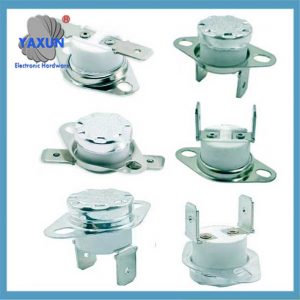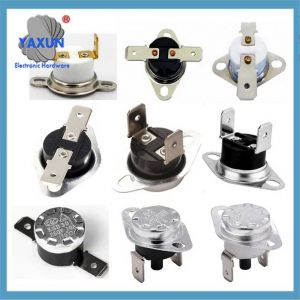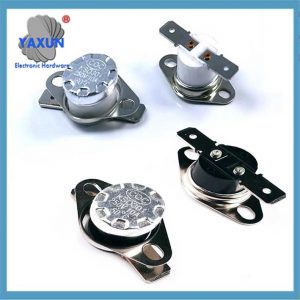The following is a detailed analysis of the structural characteristics, working principle and technical points of the core temperature sensing element of the KSD301/KSD302 temperature switch – the bimetallic strip:
I. Core characteristics of bimetallic temperature sensing element
| Features | Technical description |
| Material structure | A composite of two metal alloys with different expansion coefficients (such as nickel iron/manganese copper), stamped into a disc-shaped thin sheet structure |
| Operation principle | Temperature rises → Bimetallic strip deforms due to heat → Arch height suddenly changes → Drives the mechanical mechanism to instantly bounce and open and close the contacts |
| Response speed | Millisecond-level sudden jump action to avoid arc damage to the contacts |
| Temperature accuracy | Tolerance as low as ±2℃ (high-precision type), conventional models ±3~10℃, determined by the heat treatment process of the metal sheet |
| Reset mechanism | After the temperature drops, the bimetallic strip returns to its original state and the contacts automatically reset (normally closed type closes when the temperature drops, normally open type opens when the temperature drops) |
KSD301 Temperature Switch Parameters
II. Decomposition of working process
mermaid Copy Code
graph LR
A[normal temperature state] –>|bimetallic strip free and straight| B[contact closed/open]
C[temperature rises to action value] –>|bimetallic strip arch height sudden change| D[instantaneous bounce drive mechanism]
D –>|normally closed type| E[contact disconnect circuit]
D –>|normally open type| F[contact connection circuit]
G[temperature drops to reset value] –>|bimetallic strip returns to straight| B
Key point: The bimetallic strip arch height sudden change is the source of the name “snap-type cut-off switch”, ensuring that the contact action is clean and has no intermediate state.
III. Key points for use and maintenance
Avoid mechanical damage
It is forbidden to squeeze the bimetallic strip with external force, as deformation will cause the action temperature to drift or fail.
Heat conduction requirements
The installation surface needs to be flat and clean, and thermal grease should be applied to ensure that heat is transferred to the metal strip in time.
Temperature limitations
Bimetallic strip tolerance limit: short-term ≤300℃, long-term ≤240℃ (overheating is prone to metal fatigue).
Load matching
It is strictly forbidden to exceed the rated current (such as 10A model connected to 15A load), as the high temperature of the arc will sinter the bimetallic strip.
IV. Fault diagnosis reference
Contact adhesion : Excessive load current causes arc welding, and the load matching needs to be checked and the model needs to be replaced.
Action delay : The installation surface is poorly thermally conductive or the bimetallic strip is aging, so reapply silicone grease or replace the component.
Reset failure : The bimetallic strip is deformed and stuck, and the thermostat needs to be replaced as a whole.
▶️ Summary: The bimetallic strip is the “temperature sensor + actuator” integrated component of KSD301. Its disc-shaped structure design and alloy ratio directly determine the temperature control accuracy and reliability.
 English
English Afrikaans
Afrikaans العربية
العربية বাংলা
বাংলা bosanski jezik
bosanski jezik Български
Български Català
Català 粤语
粤语 中文(简体)
中文(简体) 中文(漢字)
中文(漢字) Hrvatski
Hrvatski Čeština
Čeština Nederlands
Nederlands Eesti keel
Eesti keel Suomi
Suomi Français
Français Deutsch
Deutsch Ελληνικά
Ελληνικά हिन्दी; हिंदी
हिन्दी; हिंदी Magyar
Magyar Bahasa Indonesia
Bahasa Indonesia Italiano
Italiano 日本語
日本語 한국어
한국어 Latviešu valoda
Latviešu valoda Lietuvių kalba
Lietuvių kalba македонски јазик
македонски јазик Bahasa Melayu
Bahasa Melayu Norsk
Norsk پارسی
پارسی Polski
Polski Português
Português Română
Română Русский
Русский Cрпски језик
Cрпски језик Slovenčina
Slovenčina Slovenščina
Slovenščina Español
Español Svenska
Svenska ภาษาไทย
ภาษาไทย Türkçe
Türkçe Українська
Українська اردو
اردو Tiếng Việt
Tiếng Việt



